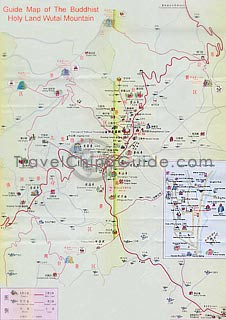Mount Wutai Facts
Location: in Wutai County in Xinzhou Region, Shanxi Province
Area: 2,837 square kilometers (1,095.4 square miles)
Average Altitude: 1,000 meters (over 3,281 feet)
The most holy land of Chinese Buddhism, Mount Wutai is rated on both the list of the first group of national scenic spots designated by the State Council, and the list of the Top 10 scenic spots in Shanxi Province. It is as famous as
Mt. Emei in Sichuan Province,
Mount Putuo in Zhejiang Province, and
Mount Jiuhua in Anhui Province, all of which are renowned as the four sacred Buddhist Mountains. Its five main peaks, positioned east, south, west, north, and in the middle, embrace one another with broad and plain terraces rather than forests on their tops. That is why it bears the name "Wutai Shan" (Mountain of Five Terraces). The summit of the northern peak which is famed as being the "Roof of Northern China", reaches 3061.1 meters (10,043 feet). Besides the religious aspect, the beauty of rising and falling ridges of mountains, exotic rocks, crisscrossed gullies, crystalline waters and towering green forests also gives the mountain its reputation as a colorful and notable scenic resort.
The beautiful scenery in Mount Wutai is a masterpiece of exquisite acts of nature, predominantly visible over the five main peaks: Wanghai Peak in the east, Guayue Peak in the west, Jinxiu Peak in the south, Yedou Peak in the north, and the central Cuiyan Peak.
Wanghai Peak (Peak Overlooking the Sea) in the East
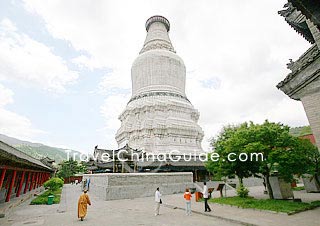 |
Great White Pagoda in
Tayuan Temple, Mount Wutai |
1 kilometer (0.6 miles) east of Taihuai Town in Wutai County, there is Wanghai Peak. Visitors standing on the top of the peak can appreciate the height of 2,795 meters (9,169.9 feet). It is wonderful to see the sunrise in the morning from this location. Out of a sea of floating clouds and writhing mist, the sun rises with thousands of golden rays. It fills visitors with amazement, as they can believe it is the sun rising above the real sea.
Guayue Peak (Hanging Moon Peak) in the West
Guayue Peak reaches an altitude of 2,773 meters (9,097.8 feet) and is 13 kilometers (8.1 miles) west of Taihuai Town. This peak provides unique imagery in the evening when visitors can see the elegant and serene sight of the graceful but hazy moon hanging above dense pine trees.
Jinxiu Peak (Splendor Peak) in the South
Jinxiu Peak is 2,485 meters high (8,152.9 feet), and 12 kilometers (7.5 miles) south of Taihuai Town. This peak's beauty is in the colorful flowers that grow all over it, and emit scents and perfumes from early May until late August. They decorate the peak by making it look as if it is wearing a floral silk coat.
Yedou Peak (Peak of Flourishing Leaves) in the North
This peak, 5 kilometers (3.1 miles) north of Taihuai Town, is the highest point of Mount Wutai, as well being the highest in Northern China, at 3,058 meters (10,032.8 feet). On the terrace of the peak, there is a natural pool that is over 300 square meters (358.8 square yards) From the terrace looking towards the north, Mt. Hengshan looms blanketed in endless greenery.
Cuiyan Peak (Peak of Green Rocks) in the middle
According to its name, one can guess the scenery of this peak. The rocks are green not because of their own color, but because of the moss on their surface. The huge rocks resemble moving dragons when seen in sunlight, from which the name "dragon-writhing rocks" has been derived.
Wutai Mountain Temple
It is said that Mount Wutai
is the dwelling place of Manjusri Bodhisattva. 360 temples were built here dating back to the Tang Dynasty (618-907) but now only 47 of them exist. Over the years, incalculable numbers of pilgrims and visitors have come here. Among these magnificent temples, five are the most famous: Xiantong Temple, TayuanTemple, Manjusri Temple (Summit Bodhisattva), Shuxiang Temple, and Luohou Temple. Xiantong Temple
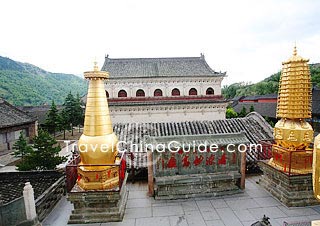 |
| Xiantong Temple |
It has the longest history and is the most prestigious. Occupying an area of 80,000 square meters (95,682 square yards), it was built initially in 68, during the Eastern Han Dynasty (25-220), with the additions built by succeeding dynasties. Now it plays the most important role among the temples, therefore, the Buddhist Association of Mount Wutai is situated there. The court-styled construction of it includes seven palaces, in one of which Wenshu (Manjusri) Bodhisattva's statue was engraved and worshiped. The copper bell in front of the gate is the biggest bell on Mt. Wutai, with a weight of 9,999.5 jin (22,045.9 pounds). Its toll can be heard around the entire mountain.
Tayuan Temple
The 75.3-meter-high (247-feet-high) Tayuan Temple is the symbol of Mount Wutai, so it becomes a "must-see". Principally it possesses the white Tibetan-style dagoba also called Dabai Pagoda (Big White Pagoda).
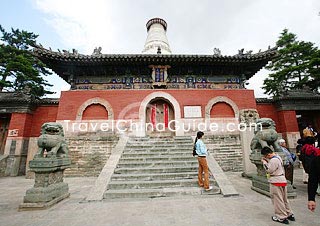 |
| Tayuan Temple |
Since it stands in front of the other temples in Taihuai, it is even more eye-catching. Accompanying the graceful temple, there is also Wenshufa Pagoda where it is said that Manjusri Bodhisattva's hair is preserved, and the Dacangjing Pavilion (Collecting-Lections Pavilion) where volumes of lections were collected.
Manjusri Temple
Legend has it that Wenshu Bodhisattva dwelt in it, so it is also called "ZhenrongYuan" (real appearance) or "Bodhisattva Summit". It was built originally in Northern Wei Dynasty (386-534). In the time of Emperor Yongle of Ming Dynasty (1368 -1644), Lamaists began to be stationed in Mount Wutai, and the great Lama resided there. From then on, it became the principal temple of Lamaism. Emperors Kangxi and Qianlong of the Qing Dynasty (1644-1911) both went there and left ever-lasting epigraphs.
Shuxiang Temple
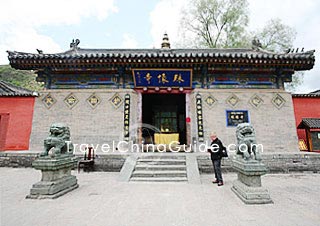 |
| Shuxiang Temple |
It is the southwest neighbor of Tayuan Temple. Built in Yuan Dynasty (1271-1368), it covers 6,400 square meters (7,654.6 square yards), and encompasses over 50 palaces and halls. Among them Manjusri Pavilion is the largest one in the center of the Taihuai County, with Manjusri Bodhisattva's statue in it. A clear spring flows out of the temple named "Banruo" or "Prajna", meaning "adding wisdom", whose water was used in the courts.
Luohou Temple
To the east of the Xiantong Temple, Luohou Temple was set up as a Lamaist temple in the Tang Dynasty. One of its wonders is a wooden lotus-shaped flower. Machinery turns it and the wooden petals open and close. Inside are carved Buddhist figures on a square platform.
For tourists who want to visit all Manjusri Bodhisattva's statues in the five temples but cannot for time constraints or other reasons, Dailuo Peak (Dark Green Snail Peak) is a wonderful place to visit, because Wufang Manjusri Palace (Palace of Manjusri Bodhisattvas from five directions) houses statues resembling the five Manjusri Bodhisattvas of each terrace. It is located to the east of the temple group in the center of Taihuai Town. 1,080 steps lead to the top of the snail-shaped peak and a cable car is also available for convenience.
Besides these temples, there are other exquisitely constructed ones, such as Jinge Temple (golden temple), Nanchan Temple, Dailuoding, Shifangtang, Wangfo Temple, and so on.
Other Resources
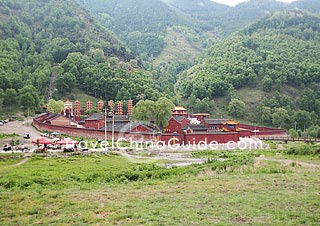 |
| Shancai Cave |
Mount Wutai is resplendent in many resources owing to its natural conditions and important role in Buddhism.
Over 600 species of plants can be found, of which more than 150 species of grass can be used as rare herbs. Special local produce, Taimo, (mushrooms grown on the tops of peaks of Mount Wutai) is of quite high nutritional value and with a delicate taste.
Since many temples are interspersed in Mount Wutai, numerous art works were cared for and have been preserved as relics-sculptures, murals, calligraphy, as well as architecture. Pagodas built in the style of those in ancient India added new types to traditional ones. Nanchan Temple and Foguang Temple, built in the Tang Dynasty, are representatives of the ancient wooden style of construction, and have the longest history amongst the temples in the mountain.
How to get to Mount Wutai
How to get to Wutai Shan by bus
1. A bus departs at 6:30 from Taiyuan Railway Station to the Mt. Wutai directly.
2. Take a bus from Taiyuan East Bus Station to Wutaishan Bus Station, and then take a taxi to the mountain area. The bus is available from 6:30 to 9:10 with an internal of about 30 minutes.
How to get to Wutai Shan by train
Take a train from Taiyuan Railway Station to Wutaishan Railway Station, and it takes 3.5 – 6h. After arrival, you can take the regular red bus from the railway station to the scenic area or charter a car to get there.
How to get to Wutai Shan by air
Xinzhou Wutaishan Airport is 70 kilometers (43 miles) away from Mount Wutai. Airport shuttle buses arrive at the scenic area directly which operate before 20:00 and leave when there are passengers. The duration is about 2 hours and the fare is CNY 80.
| Entrance Fee | Apr. - Oct.: CNY 135
Nov. - Mar.: CNY 118
Free for children under 1.2m (3.9 feet) |
| Opening Hours | The mountain area opens all day, but scenic spots opens roughly from 6:30 to 20:00. |
| Cable Car Ticket | Dailuo Peak: CNY 50 (one-way); CNY 80 (round-trip) |
| Fomu Cave: CNY 50 (one-way); CNY 85 (round-trip) |
| Cable Car Service Hours | 7:00 - 17:00 (only for reference) |
- Last updated on Apr. 12, 2024 -
